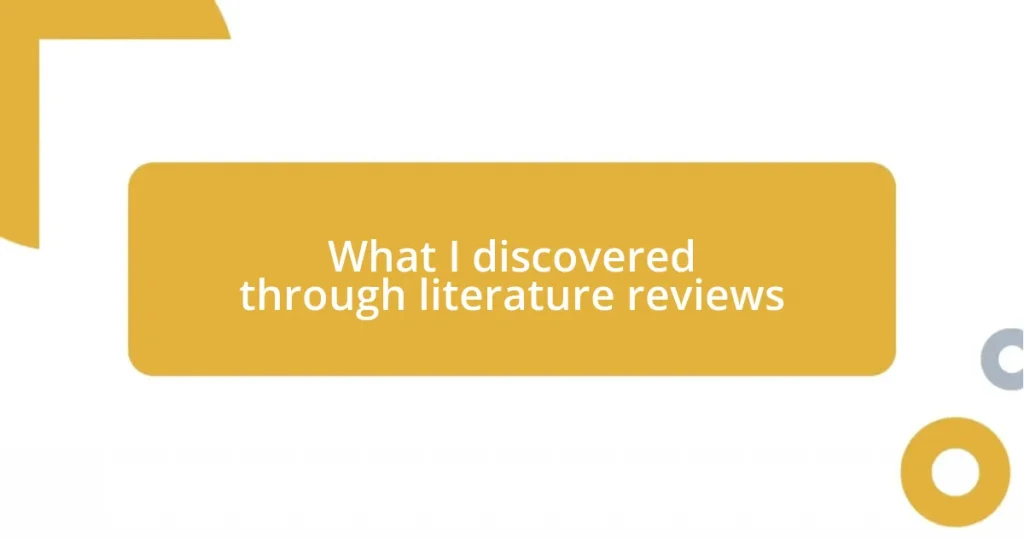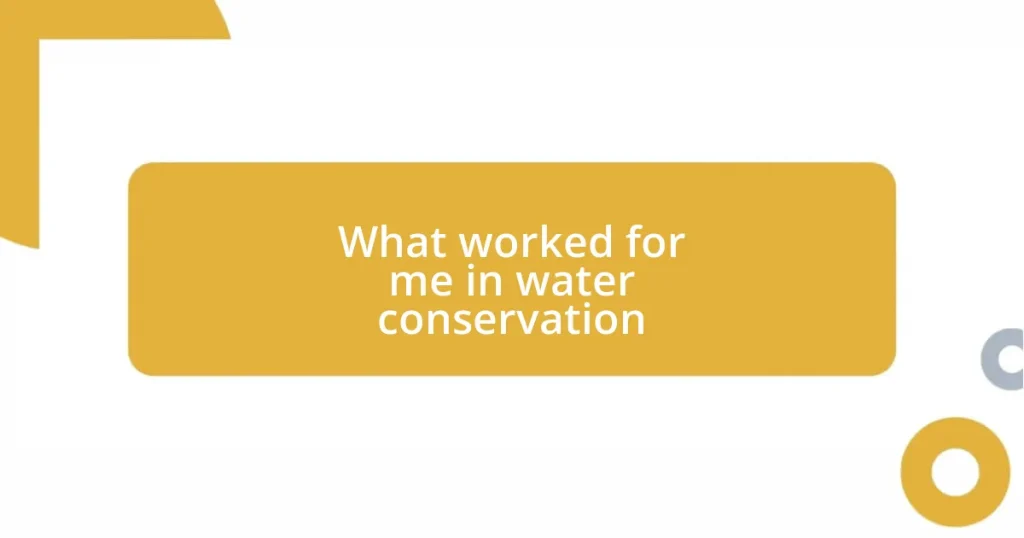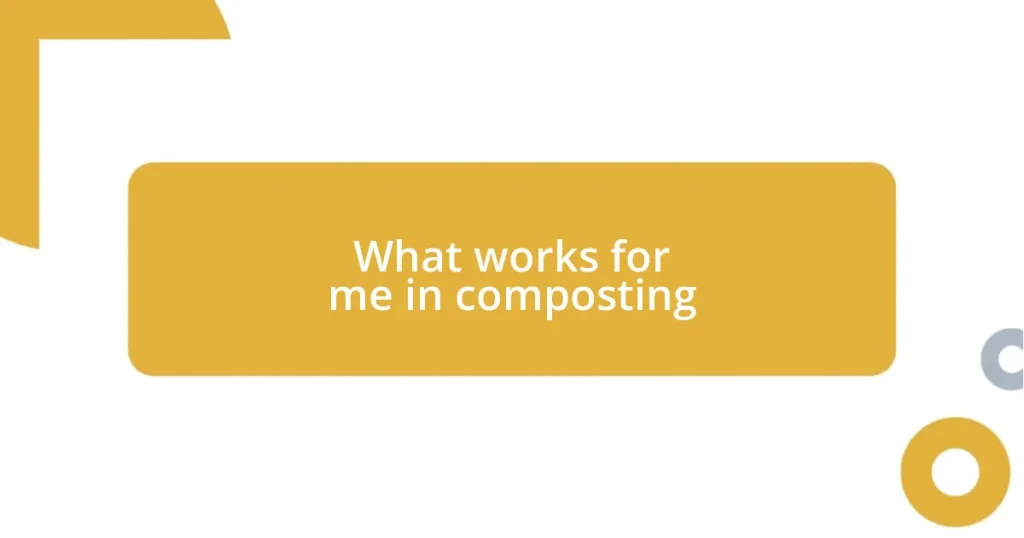Key takeaways:
- Literature reviews are essential for identifying research gaps and guiding future studies by offering a comprehensive picture of existing knowledge.
- Critical analysis and synthesis of findings are pivotal in developing a well-rounded understanding of a topic, encouraging deeper engagement and innovative perspectives.
- Common pitfalls in literature reviews include confirmation bias, lack of structure, and failure to incorporate recent studies, all of which can undermine the quality of the review.
- Utilizing a thematic approach and maintaining a reflective journal can enhance the effectiveness of literature reviews by helping to organize insights and uncover new questions.
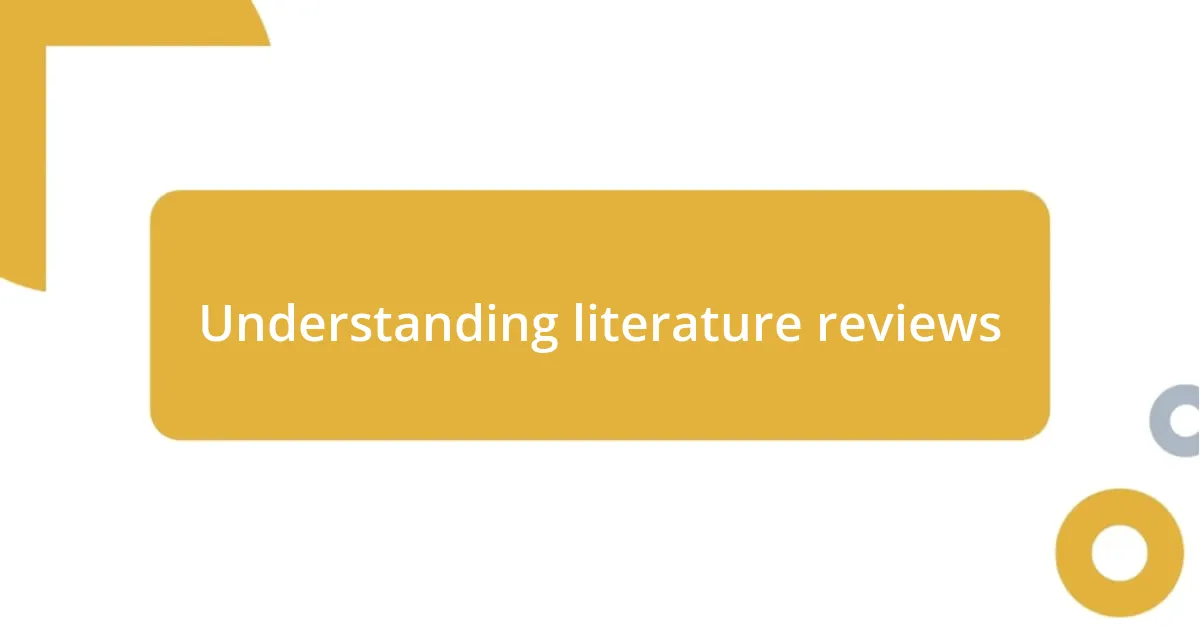
Understanding literature reviews
Understanding literature reviews opens up a world of discovery for researchers and curious minds alike. I remember diving into my first literature review feeling a mix of excitement and intimidation. It felt like wandering through a vast library, where every book held a piece of knowledge, and I was tasked with piecing those fragments together to form a clear picture.
As I engaged with various studies and articles, something clicked for me: literature reviews are more than just summaries; they are a conversation across time and disciplines. Have you ever noticed how different authors can interpret the same data in wildly different ways? This realization was pivotal for me. It emphasized that every literature piece carries the author’s unique perspective and biases, and recognizing these adds depth to my understanding.
The process of crafting a literature review also cultivates critical thinking skills. I found myself constantly asking, “What gaps exist in this research?” and “How do these findings relate to my own work?” This introspection not only enhances my research but also fuels my curiosity, allowing me to approach each subject with a fresh perspective and eagerness to learn. It’s fascinating how these reviews can bridge knowledge, fostering connections that spark new ideas and innovations.
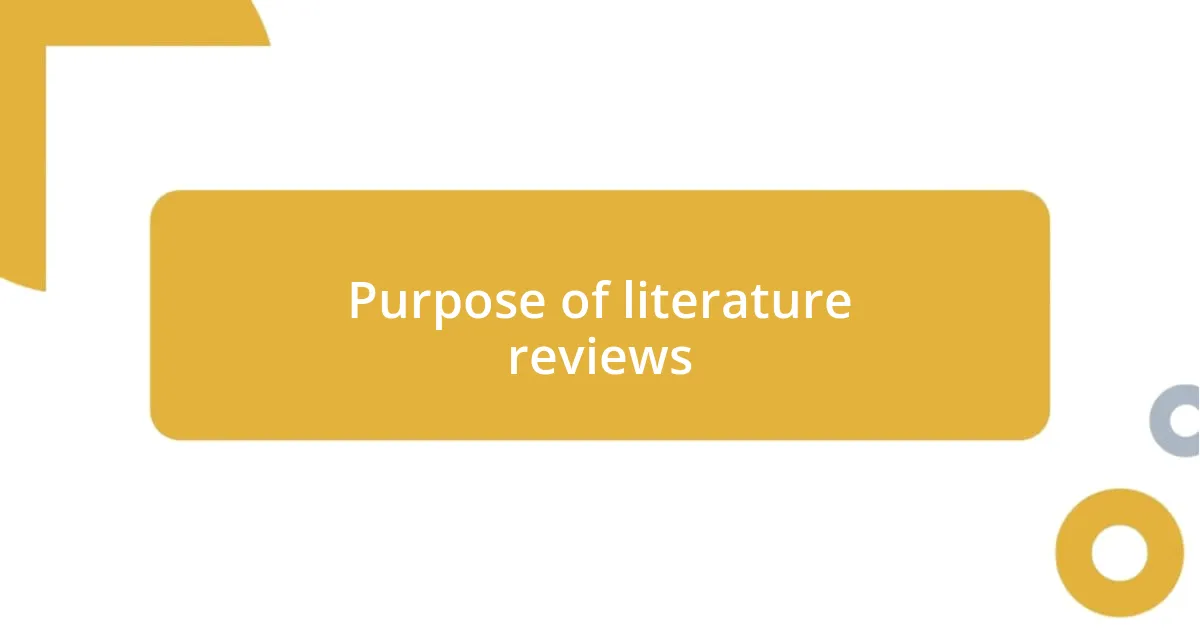
Purpose of literature reviews
Literature reviews serve a vital purpose in shaping research landscapes. I’ve found that they not only summarize existing knowledge but also highlight trends and themes that can help guide future studies. I remember feeling a sense of clarity when I realized how much these reviews could inform my own research questions, revealing paths I hadn’t previously considered.
Another key aspect is their role in establishing a framework for understanding a topic. While reviewing a collection of papers, I often confront conflicting viewpoints. This not only enriches my perspective but also encourages deeper engagement with the material. Have you ever wrestled with differing interpretations? That grappling with diverse viewpoints made me appreciate the complexity of knowledge.
Furthermore, literature reviews can identify gaps in existing research. It’s invigorating to pinpoint areas where more exploration is needed. For instance, in one of my reviews, I discovered a distinct absence of studies on a particular demographic. That realization inspired me to focus my research efforts there, igniting a passion for uncovering new insights. This transformative potential is what makes literature reviews an essential part of any researcher’s toolkit.
| Purpose | Description |
|---|---|
| Summary of Knowledge | They condense existing research, presenting current insights and trends. |
| Framework Establishment | They help organize information, guiding researchers through different perspectives. |
| Gap Identification | They reveal areas where further research is necessary, paving the way for new inquiries. |
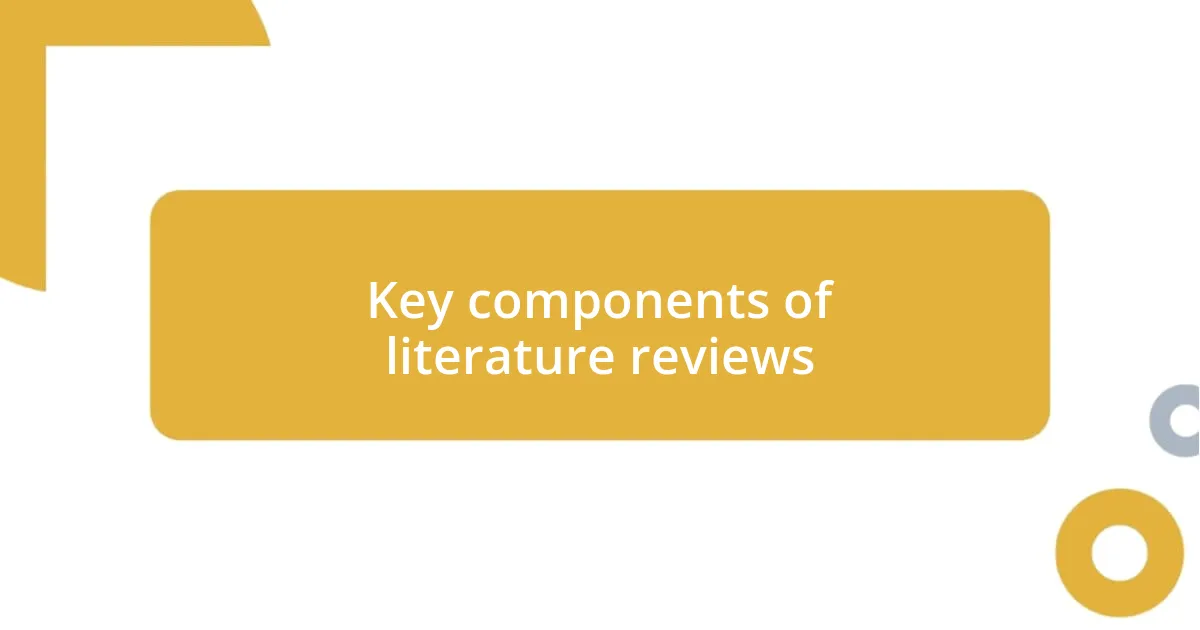
Key components of literature reviews
When I think about the key components of literature reviews, I’m struck by how they truly act as the backbone of effective research. Each review is built on essential elements that contribute to a comprehensive understanding of a subject. It’s like assembling a puzzle; the pieces must fit together seamlessly to reveal a coherent image.
Here are some key components to consider:
-
Search Strategy: This involves a systematic approach to selecting relevant literature, ensuring that no significant study is overlooked. I recall meticulously developing my search terms, feeling a sense of accomplishment every time I unearthed a pivotal article that added to my narrative.
-
Critical Analysis: Merely summarizing isn’t enough; I’ve learned that evaluating the strengths and weaknesses of each study is crucial. Reflecting on how biases or methodologies impact findings has made my writing much more robust.
-
Synthesis of Findings: Integrating insights from multiple sources creates a narrative that showcases the broader context. When I finally saw my collected information come together, it felt like orchestrating a symphony—each article adding depth to my overall composition.
On a broader scale, the ability to weave these components beautifully allows researchers to articulate a well-rounded view of their chosen topic. I often find myself inspired by the connections I make during this process, which leads to fresh hypotheses and innovative perspectives.
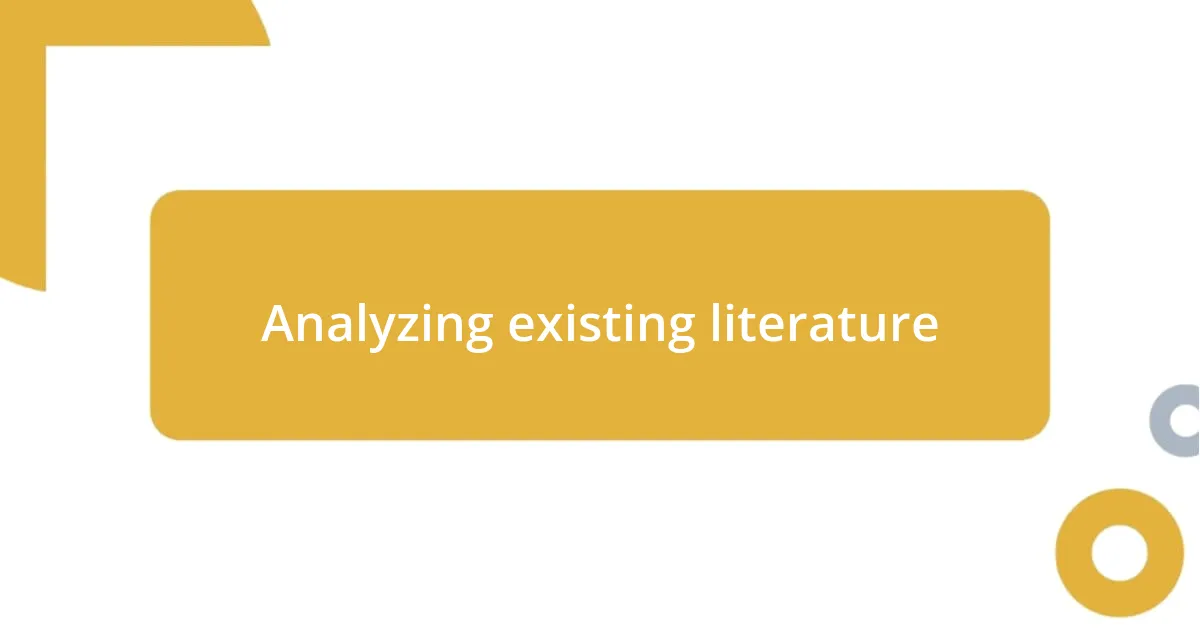
Analyzing existing literature
Analyzing existing literature is a fascinating and sometimes overwhelming journey. I vividly remember the first time I sat down with a stack of articles; it felt like diving into an ocean of ideas. Sorting through them, I realized I was not just skimming the surface—I was searching for patterns and connections that could reshape my understanding. Have you ever felt lost in a sea of information? It’s an experience that, while daunting, can spark incredible insights when you begin to recognize underlying themes.
As I delved deeper, I discovered that critical analysis played a pivotal role in my exploration. It’s not enough to just summarize what others have said; I’ve found it essential to weigh their arguments against one another. For example, I once compared two studies with conflicting conclusions about the same phenomenon. The process of dissecting their methodologies and biases was enlightening, revealing nuances I hadn’t considered before. It struck me how different perspectives can coalesce into a richer understanding.
Furthermore, synthesizing findings into a coherent picture can be both exhilarating and challenging. I’ve often chased that “aha!” moment when disparate pieces of information suddenly align. During one of my literature reviews, I encountered several studies that seemingly had little in common. Yet, by relating their conclusions, I was able to uncover a unique narrative thread that pointed to an exciting new area of research. That moment—when clarity emerges from chaos—is what makes analyzing literature so rewarding. Don’t you just love when connections click into place?
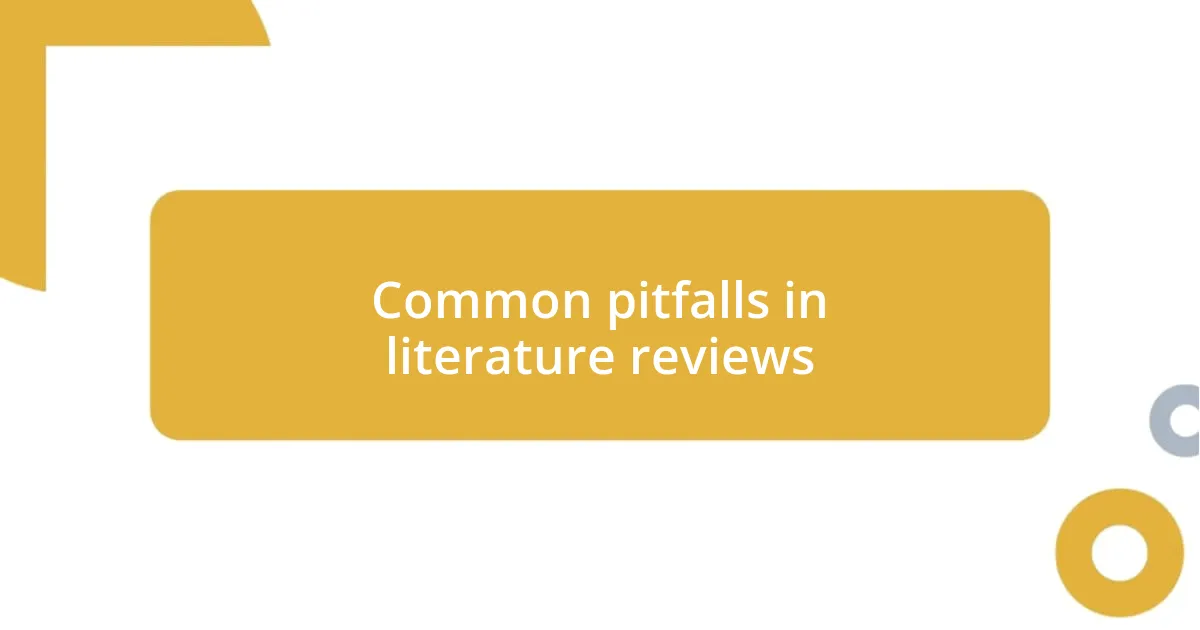
Common pitfalls in literature reviews
Identifying common pitfalls in literature reviews can save you a lot of time and effort. One major issue I’ve encountered is confirmation bias, where it’s all too easy to focus solely on studies that support my preconceived notions. I recall a project where I initially only selected articles that aligned with my hypothesis. It turned out to be a disservice, as crucial counterarguments and alternative perspectives were left unexplored, ultimately weakening the review.
Another pitfall is the lack of a clear structure. When I first started writing literature reviews, I underestimated how vital organization is. The scattered approach I took made it challenging for readers to follow my arguments. I learned that a well-defined structure isn’t just about clarity; it helps me maintain focus and coherence while guiding my audience through the narrative I want to build.
Additionally, failing to update my review with the most recent studies is something I’ve grappled with. Research evolves quickly, and it’s easy to overlook newer contributions that could enhance my work. I vividly remember discovering a groundbreaking study after completing my draft—it felt like finding a missing piece that could have transformed my entire understanding. Have you ever found yourself in a similar situation, realizing too late that you could have enriched your analysis? It underscores the importance of continually assessing and refining my literature review as new insights emerge.
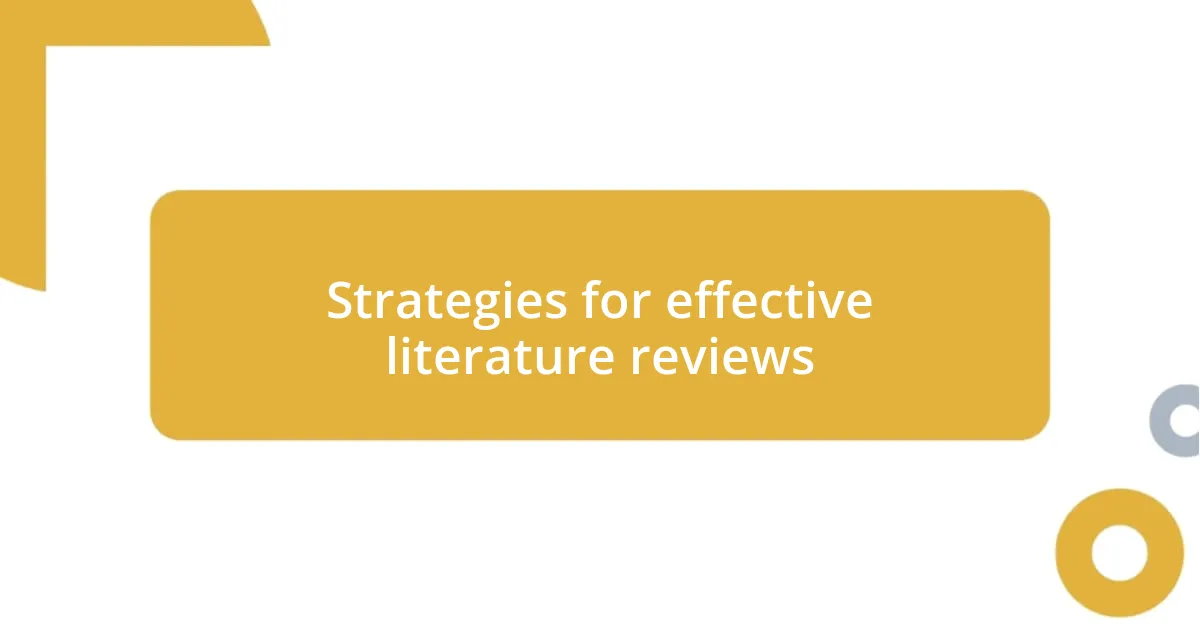
Strategies for effective literature reviews
Crafting an effective literature review requires a strategic approach that involves careful planning. I’ve learned that setting clear objectives early on is vital. For instance, during one of my first reviews, I jumped into the literature without a clear question in mind, and I ended up with a chaotic collection of articles. Once I started defining specific goals, like “How do these theories apply to my current research question?” I found it much easier to navigate the literature landscape. Have you ever faced that moment of clarity when everything aligns?
Also, utilizing a thematic approach can make a world of difference. When constructing my reviews, I often categorize my findings into themes. One time, while sifting through articles related to mental health, I noticed recurring themes regarding stigma and treatment accessibility. By organizing my review around these key themes, it became much more coherent, drawing connections that emphasized the significance of each perspective. I felt like a detective piecing together clues to solve a broader mystery. Isn’t it engaging when the literature starts to tell a story?
Moreover, maintaining a reflective journal during the review process has been a game-changer for my analysis. I jot down insights and thoughts as I read, which has helped me to connect the dots over time. There was a period when I felt overwhelmed by the sheer volume of data, and it helped to step back and clarify my thoughts on paper. This practice not only aids in retaining information but also unveils questions and ideas that may not surface during the initial reading. Have you ever had a moment where writing something down sparked a new idea? It’s such a rewarding experience.
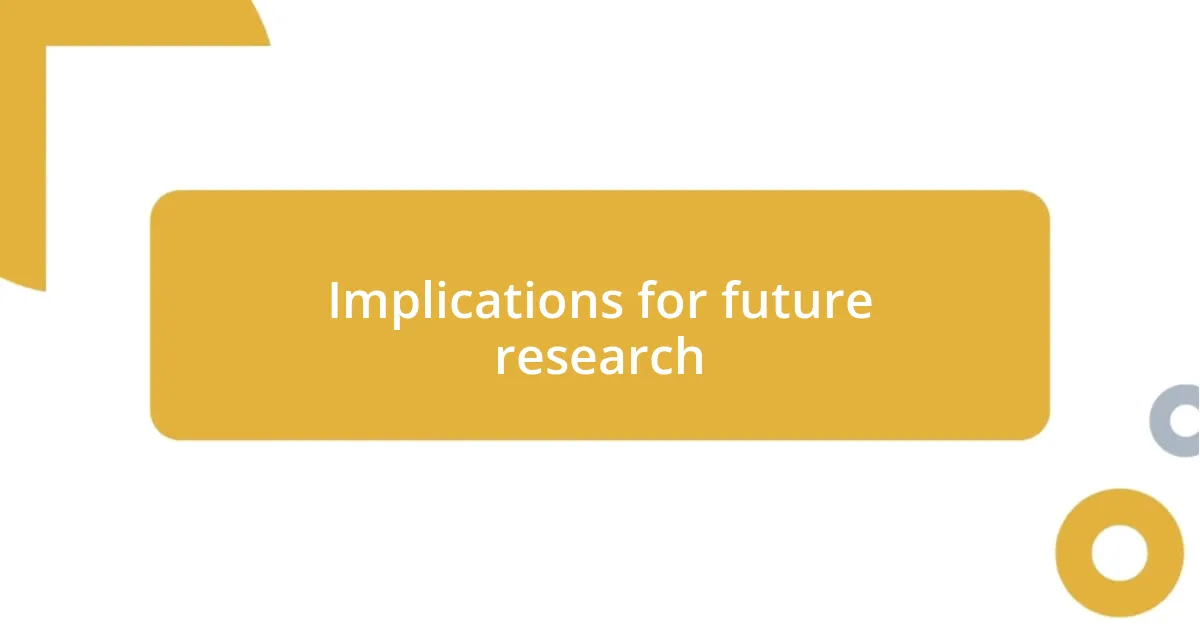
Implications for future research
One notable implication for future research is the need for enhanced methodological rigor in literature reviews. During my own studies, I discovered that many reviews lacked a clear methodology, which undermined their reliability. I remember feeling puzzled by how conclusions could differ so vastly across studies; it often boiled down to differing approaches in selecting and analyzing literature. Wouldn’t it be fascinating if researchers consistently documented their review processes? This transparency could foster stronger trust in findings and pave the way for a more standardized approach across disciplines.
Additionally, I’ve learned that interdisciplinary collaboration can significantly enrich literature reviews. There was a time when I approached a topic solely from my own field, missing out on valuable insights from adjacent disciplines. It wasn’t until I engaged with colleagues in psychology that I unveiled connections I had overlooked. Isn’t it intriguing how different perspectives can illuminate aspects of a problem, leading to more innovative solutions? Future research should encourage collaboration across fields, as it can offer a more holistic understanding of complex issues.
Lastly, the role of technology in facilitating literature reviews should not be underestimated. In an era where data is abundant, I’ve noticed that leveraging digital tools can streamline the process significantly. For instance, employing reference management software transformed how I organized my sources, making it easier to track themes and ideas. Have you ever considered how technological advancements could make literature reviews more efficient? There’s immense potential in harnessing these tools to enhance the quality and efficiency of future research efforts.










